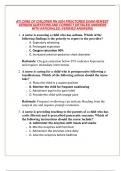Exam (elaborations)
ATI CARE OF CHILDREN RN 2024 PROCTORED EXAM NEWEST VERSION QUESTIONS AND CORRECT DETAILED ANSWERS WITH RATIONALES (VERIFIED ANSWERS)
- Course
- Institution
ATI CARE OF CHILDREN RN 2024 PROCTORED EXAM NEWEST VERSION QUESTIONS AND CORRECT DETAILED ANSWERS WITH RATIONALES (VERIFIED ANSWERS)
[Show more]



